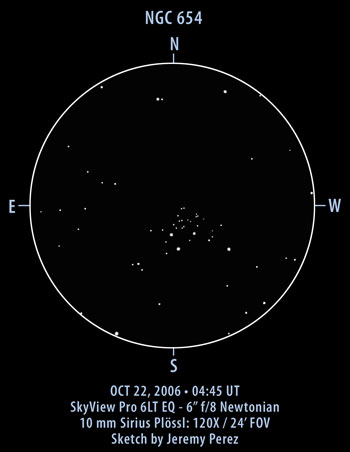
Observation Notes:
This misty cluster shared the same low power field of view as NGC 663 to the south. At 120X, the cluster takes on a triangular shape with several doubles throughout. A bright star marks its southern apex. Of the 58 stars plotted in the sketch, 28 were within what I perceived to be the boundaries of the cluster. A couple of the brighter stars are likely foreground objects. I made the mistake of leaving the eyepiece at an uncomfortable angle, right over one of the tripod legs when I began what turned out to be a 40 minute long sketch. I wasn’t able to slide the chair up to it, so I ended up tip-toeing my way through the last half of the sketch. That was a bit of a bummer.
Object Information
NGC 654 was discovered by Friedrich Wilhelm Herschel in 1787. According to Catalogue of open cluster parameters from UBV-data. (Loktin+, 1994), the cluster is about 2,422 parsecs distant (7,896 light years). According to Star Clusters and Associations, Selected Data (Alter+ 1970) the distance is 1,600 parsecs (5,216 ly). The cluster is also catalogued as Cr 18, Mel 9, OCL 330, Lund 53, H VII-46, h 145, GC 387.
| Subject | NGC 654 |
| Classification | Open Cluster (II 2 r) |
| Position* | Cassiopeia [RA: 01:43:59.4 / Dec: +61:52:58] |
| Size* | 5.0′ |
| Brightness* | 6.5 vMag. |
| Date/Time | October 21, 2006 – 09:45 PM (October 22, 2006 – 04:45 UT) |
| Observing Loc. | Cinder Hills Overlook, Sunset Crater National Monument, AZ |
| Instrument | Orion SVP 6LT Reflector (150 mm dia./1200 mm F/L) |
| Eyepieces/Mag. | 10 mm (120X) |
| Conditions | Clear, Calm |
| Seeing | 5/10 |
| Transparency | Mag 6.8+ NELM |
| *Sources | NGC/IC Project |
*Based on published data.